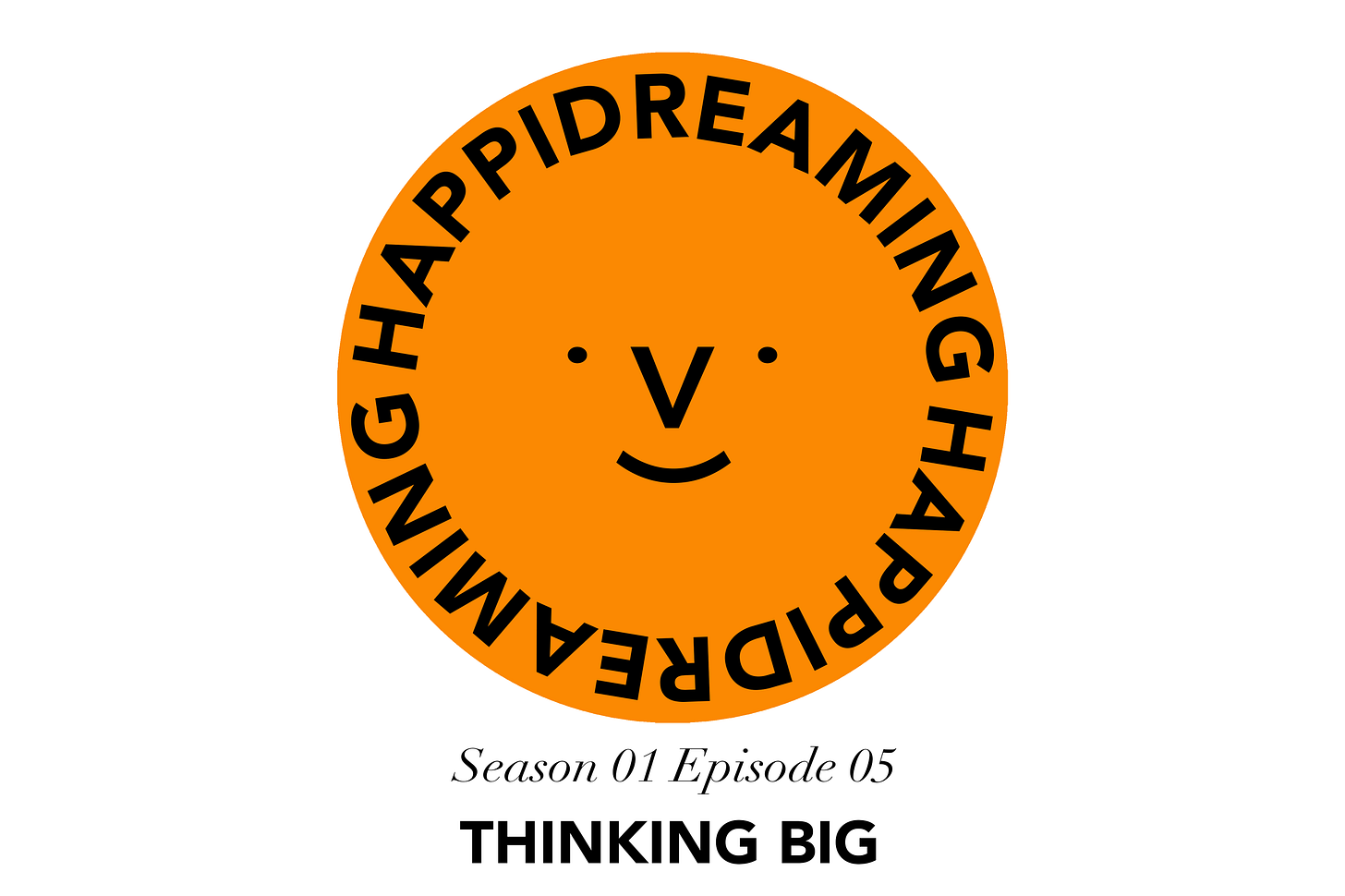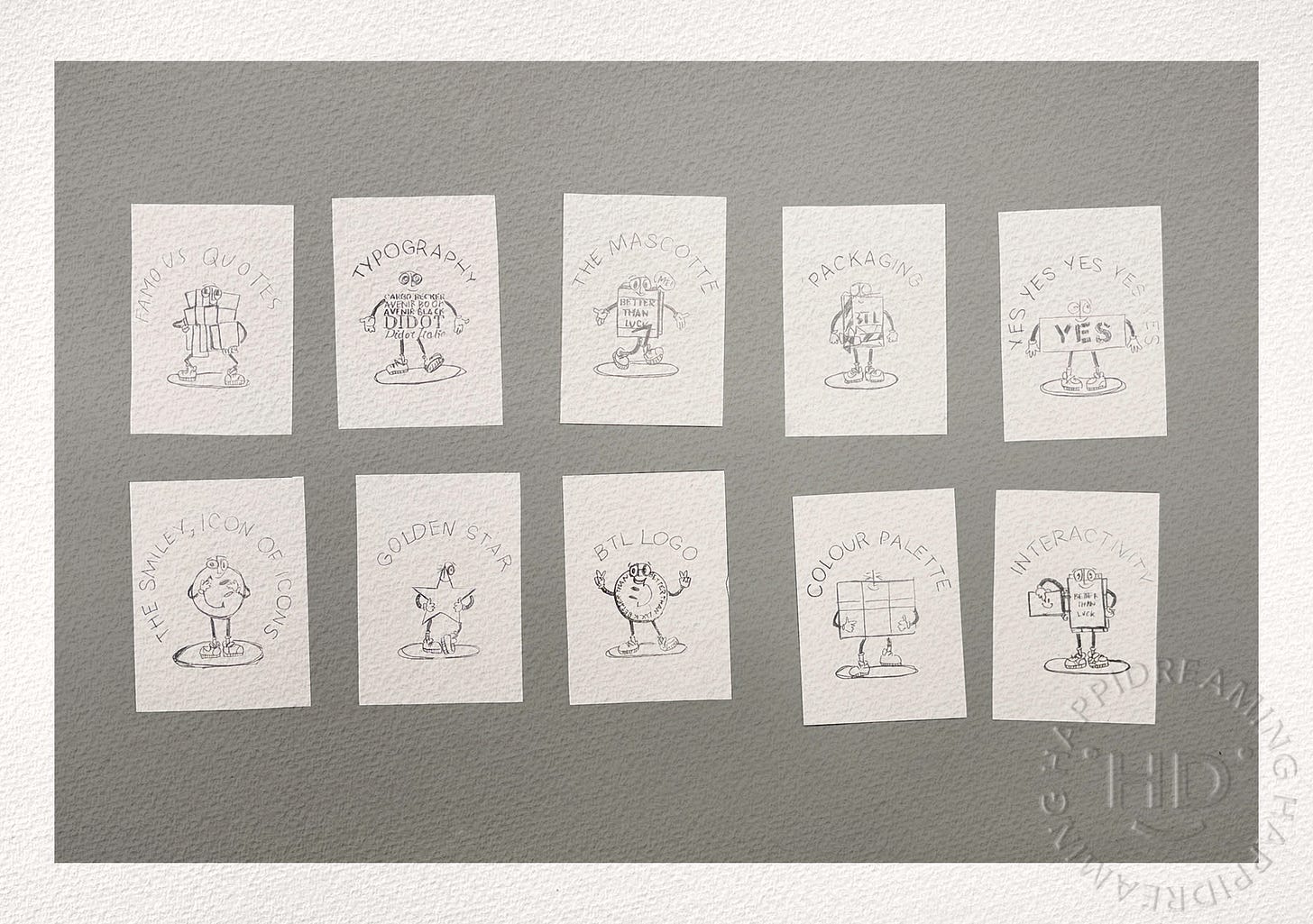THINKING BIG
S01E05. Opening night and—eureka!
PREVIOUSLY — Still unsure what to perform at her friend Witch’s upcoming birthday party, BBH starts rehearsing her storytelling. We’re introduced to the world of her social life—sumptuous? suffocating?—and to several characters, including Manticore (a crush: once married, now divorced) and Monster, an illustrator whose genius Witch has decided to fund, aiming to “turn him into the next KAWS.” As the debut of Witch as a patron and Monster as her protégé approaches (and, tick-tock, after that comes BBH’s yet-to-be-imagined performance), BBH keeps studying Better Than Luck. And thanks to its warnings and encouragements, she keeps showing up at the keyboard, week after week, honouring her pact with us to lead us, one instalment at a time, toward HAPPY DREAM—her not-yet-written novel.
So just as I was downing yet another cocktail, Monster leaned in and whispered: “All it took was thinking big.”
That’s it?
That’s the only difference between a sketch on paper and its 260cm resin version, centrepiece of a packed gallery, on sale for some ridiculous price? Is thinking big all it takes to make the quantum leap from potential to expression? But wait—let’s back up a second.
Picture this: you're eleven and you’re sitting in the front row (left side) of a classroom when a crumpled note gets passed from hand to hand until it lands on your desk. It reads: YOU’RE BEAUTIFUL — Anonymous. You blush and although you pretend otherwise you know exactly who it’s from: same handwriting as the cutest boy in class, a sort of human-Casper who always writes things on desks, walls, blackboards. He sits in the back row, far right and you’re stunned (let it be clear: this is your first love letter) while your desk mate (the one who today wears Comme Des Garçons and black lipstick) bites her lower lip and rolls her eyes. “You know exactly who sent it,” she mutters. “Don’t act all dumb”.
Now imagine a second note arrives. This one’s more battered, folded from its long journey across the room and inside is a cartoonish doodle: heart with eight-shaped eyes and an L-shaped nose, tubular arms and legs, gloved hands, sneakers, and a speech bubble that says: ACTUALLY, YOU’RE STUNNING — (Monster).
Imagine you’re burning up, because you are the sun and its light, and you’re not yet equipped for such pride—or such turmoil.
Great. Fast-forward twenty years: you’re thirty-one, attractive, and wide open to possibility.
You’ve spent the last year teetering between euphoria and annihilation, and the entire afternoon trying to decide what to wear. In recent weeks, you’ve stared at the ceiling hoping it might whisper an idea for next month’s performance. You’ve suffered: Not Having The Idea is a physically painful state. Everyone expects something witty from you (and if you don’t perform, would that draw even more attention?). Now, entering the already-crowded opening of your friend’s new gallery—your old desk mate, here called Witch—you come face to face with a giant, glossy, acrylic version (swear to god, at least three metres tall) of that very doodle: a heart with eight-shaped eyes, L-shaped nose, tubular limbs, gloves, sneakers, and a speech bubble that says ACTUALLY, YOU’RE STUNNING.
As you zigzag between the scent of Dulux and Carnal Flower, you down your first Vinyl Dream (“A smooth, enveloping cocktail with contrasting flavours evoking the playful textures and surfaces of art toys”), melting into the chat chat chat of real and fake connoisseurs, you spot Manticore—a sharp-witted, indecently attractive art critic, now part of your new circle—who foolishly married some random woman (also sharp-witted, indecently attractive, and reportedly unhinged): they’ve broken up, but right then and there, despite his confident posture, you chose to steer clear. Should you greet Great Mother and Werewolf? Maybe later, you’re not in the mood for “for-your-own-good” critiques of your black dress or barbed comments about the decline of your potential in comparison with the hyper-curated success of your peers.
So you move on to the Neo-Toy Tonic (“An explosive mix of exotic ingredients, inspired by imaginary worlds and the fusion of design and art”) and lose yourself among giant, shiny sculptures of memories you thought long gone because their creator—here called Monster—was that sweet, brave classmate who once made you the object of his romantic obsession dragged out of nowhere by Witch who, with serious investments, decided to launch her gallerist debut by catapulting him where his imagination never dared go.
AT THIS POINT — BBH should compliment Witch. The rooms are packed, the pretentious drinks go down easy. Most importantly, the works work. They exist: tangible, three-dimensional. They are not a plan, nor a maybe. And the artist—he doesn’t come off as a total clown.
You were skeptical about mythologising the past, and yet look at him now. Having survived his awkward years (thanks to drawing as a coping mechanism), discovered Photoshop, the gym, and a few recreational substances, he escaped bourgeois family expectations, ditching medicine for Murakami and Supreme. He became a man: not tall, but not short either (flirting with six feet) and he’s got a solid frame, beard, long hair (a hipster D’Artagnan), and you find his flashy, smiley works… honest.
You take another sip and confront him: “Wow,” you say. He risks the presence of his girlfriend (an heiress who makes up for her lack of humility with surplus beauty—here called Nymph) and meets your eyes with a spark of inappropriate ardour, which he quickly dials back.
“Thanks. But between us—it’s all just scale.”
Under the pretext of swapping your empty glass for a new one (this time: Resin Delight, sleek and intriguing, layered like resin collectible figures), he touches your forearm. Then, leaning closer to your right earlobe, he uses modesty as a come-on:
“They’re the same old drawings, I just keep repeating myself,” he says. “All it took was removing my hesitation—and adding Witch’s money. All it took was thinking big.”
So your head now spins a little (alcohol, your new pal, is a treacherous beast), but a sharp epiphany hits you: you were the one who inspired Witch to contact Monster, by resurrecting the Mixtape and the original “YOU’RE BEAUTIFUL” note, and the tin box with the old keepsakes. You lit the fuse of your own amazement. As recently demonstrated, the effects of your new reality… are caused by you. Turns out, you’re not the passive heroine you pretend to be. So if your plan to build a personal mythology out of failure is malfunctioning, then here’s your fix: you’ll think big too. In fact—you already are. Are you writing your novel HAPPY DREAM? No, but you’re writing about wanting to write it. And you’re doing that—every week.
See, about a month ago, a Manual of Writing and Rewriting landed in your life, you welcomed it with a mix of curiosity and cynicism, superstition and hope and slowly, you’re surrendering to the evidence that its advice is lifting you. You underlined one passage and you’ve memorised it.
THIS ONE — “A story is about the rupture of an equilibrium. It focuses on a problem and resolves it through a sequence of essential scenes, showing a transformation via triumph or failure.”
Now you use that nice phrase (how long must Empress have spent polishing it to sound this crisp?)
for an important thought you’d like to share in your column as you realise that both triumph and failure are just metaphors for the only kind of success that matters: change. And you have changed: you don’t have a solo show, OK, but your hair is pink. Pink, goddamn it.
I know, I know, I was supposed to feel something specific— emotion, envy, admiration— but instead, I just felt overtaken, by pure overwhelm as an oceanic wave that stole my judgment, flipped me upside down, and in its tsunamic whoosh, tickled out a smile: and you know why?
Because I have it—I Have The Idea for my next performance!
Until next week, HAPPIDREAMERS.
— BBH










